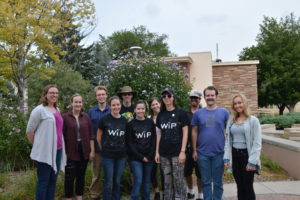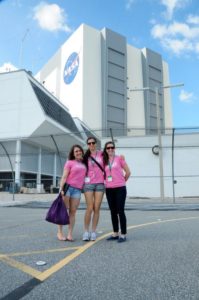 Student groups are a popular way to get involved in university life and meet people with shared interests and experiences. Student groups like Women in Physics are places to build community and collaboration amongst peers.
Student groups are a popular way to get involved in university life and meet people with shared interests and experiences. Student groups like Women in Physics are places to build community and collaboration amongst peers.
“When female students walk into a physics classroom, sometimes they’re the only one in a group of men,” said Kristen Buchanan, a professor in the Colorado State University Department of Physics. “We would really like to see the representation of women and minorities in physics come closer to approaching the distribution within the U.S. population.”
Women are underrepresented in the field of physics, receiving about a quarter of the total bachelor’s degrees awarded and even fewer postsecondary degrees according to a National Science Foundation report. At CSU, the percentage of women enrolled in the Department of Physics is 19.2%.
Buchanan is the faculty advisor for Women in Physics, a student group that was founded to encourage more women to get involved in physics.
Encouraging women in physics
Women in Physics was founded in 2012 by two students during their junior year at CSU – Valerie Jacobson and Olivia McGoffin. They explained that physics can be isolating, especially for women.
“We were often the only two women in classes,” Jacobson said. “We wanted a place to congregate and have a community. It was fun to have a place to not take yourself so seriously.”
McGoffin explained that physics is already a small community, and the number of women and minorities is even smaller. She helped found Women in Physics hoping to create a friendly, open environment for everyone in the field.
“We wanted to make physics more open and welcoming,” McGoffin said. “Science is framed as an intimidating thing, and I hope that the Women in Physics group has helped make it more accessible.”
 Since its founding, Women in Physics students have attended The American Physical Society’s Conferences for Undergraduate Women in Physics, volunteered at local schools’ science fairs as judges, arranged tours with female scientists at the National Institute for Standards and Technology laboratory in Boulder, arranged meetings with Nobel Prize winners and other prominent visitors coming to CSU, and have organized events like movie and bowling nights.
Since its founding, Women in Physics students have attended The American Physical Society’s Conferences for Undergraduate Women in Physics, volunteered at local schools’ science fairs as judges, arranged tours with female scientists at the National Institute for Standards and Technology laboratory in Boulder, arranged meetings with Nobel Prize winners and other prominent visitors coming to CSU, and have organized events like movie and bowling nights.
“The group really wanted to be about building that community,” Buchanan said. “Just anything to do with fun and getting the department and people together from physics, not just from Women in Physics.”
Like many other student groups across campus, however, the COVID-19 pandemic has impacted membership for the last few years.
Bouncing back after a pandemic
When the COVID-19 pandemic hit, shutdowns brought an abrupt halt to in-person activities across campus. Student groups like Women in Physics no longer had a way to interact with one another, Buchanan explained:
“When COVID came around, it was really tough because all of these kinds of conferences that the students used to go to were abruptly shut off. There was no mechanism to interact on campus. Initially I think everyone was in shock, so we didn’t do anything for a little while. We tried to get the group back off the ground with a series of zoom meetings, but one of the biggest challenges that we faced was that it was really hard for the students to meet each other and to build that community. That community that was very strong before COVID became very fragmented.”
Student group membership still has yet to make a comeback to pre-pandemic levels, and the same is true for the Society for Physics Students, the other student group in the department. Women in Physics is currently functioning as an informal study group.
Buchanan explained that student groups are an important way for students to be involved in university life and find a community of people with similar interests. They are also a way for students to experience things that may be hard to accomplish individually, like receiving funding for conference trips or meeting prominent physicists.
“It’s hard to describe what community can do in terms of creating a positive environment,” she said. “It just added a dimension of everyone being a community within the department. I think that’s one of the most positive things about the Women in Physics group.”
Buchanan explained that the physics department has seen a period of lower enrollment overall, but expressed hope for Women in Physics to grow in the future.
“If you’re curious about the world, physics is the way to go,” Jacobson said. “Physics is exciting and colorful – not just numbers on a chalk board.”
Women in Physics and the Society for Physics Students are both seeking new members, and looking to re-build the community, collaboration and connection they cultivated before 2020. Contact the Department of Physics or check out the Women in Physics webpage to learn more about getting involved.